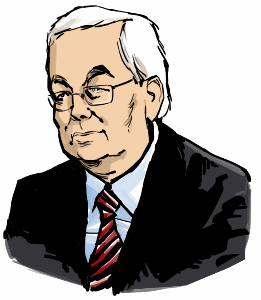Background
The Tragedie of Hamlet – A Footnote to Plato¹
Many years ago I suggested to my friend, the late Einar Pálsson (author of Rætur íslenzkra menningar – The Roots of Icelandic Culture) that the single most famous phrase in the works of Shakespeare – To be, or not to be; that is the question – should perhaps be read as To be, or not to be; that is the Quest, ION. This would identify Prince Hamlet’s trials and tribulations with Man’s Quest for the Holy Grail or Graal and link the quest to that innate human faculty which Plato ascribed to ION in his work by that name.
Advent of Christianity in the “year” 1000 A.D. is dealt with in Chapters 100-105 of Brennu-Njálssaga. As always in the case of enciphered “hidden poetry” in the Augustan-Saga-Shakespeare literary tradition, one would look to the Alpha and Omega sentences of the Section on Christianity for clues that might identify Brennu-Njálssaga with the Quest of the Holy Grail literary tradition. The two sentences read as follows:
12685 = Höfðingjaskipti varð í Nóregi. (There was a change of chieftains in Norway.)
11274 = Fara menn við þat heim af þingi. (With that people returned home from Althing.)
23959
As in 1000 + 5327 + 3450 + 11359 + 1654 + 1796 + 4000 – 4627 = 23959, where
1000 = The “year” of Christianity.
5327 = Brennu-Njáll
3450 = Þórðr – Grandson of Njáll and Bergþóra who asked to “die” with them in the fire.
11359 = Snorri Sturluson – Playcast as Þórðr at the outset of his Quest of the Holy Grail
1654 = ION – as in Snorri’s “son”, JON murtr or Little John (of later Robin Hood fame?)
1796 = GRAAL – Quest of the Holy Grail.
4000 = Flaming Sword – ‘Sent’ by Christ (Matt. 10:34)
-4627 = Tími (2315) and Rúm (2312) no more – Prince Hamlet’s ‘mortal coil shuffled off‘.
23959
Einar Pálsson, whose encyclopedic knowledge of the roots of Icelandic culture was shunned by quixotic scholars at the University of Iceland, identified Njáll Þorgeirsson, 9299, a.k.a Brennu-Njáll, with Mythical Monad.
In the saga, one of two brothers has usurped the „treasure“ of his erstwhile „wife“, daughter of Iceland’s „wisest“ man. Gunnarr, her cousin, undertakes to recover the „treasure“ from the usurper, and seeks Njáll’s advice on how to proceed.
Njáll paused for reflection, and then gave Gunnarr detailed advice which he prefaced with the words: „Hugsat hefi ek málit, ok mun þat duga,“ 14660 as in 9299 + 14660 = 23959. This is Icelandic for „I have thought the matter through, and that will suffice.“
This piece of „hidden poetry“ serves to identify Christianity, 23959, as the „treasure“ that was to be recovered from a usurper’s hands on Monad/God’s advice.
On Njáll’s advice, Gunnarr disguised himself and visited the usurper who, suspecting nothing, was legally required to heed a subpoena presented in the right format as Gunnarr proceeded to do: „Stefni ek handseldri sök Unnar Marðardóttur,“ 20387.
This is Icelandic for „I subpoena you on behalf of Unnr Marðardóttir.“ Again, this is a piece of „hidden poetry“, as in 1 + 4642 + 4385 + 11359 = 20387, where 1 = Monad, 4642 = Mörðr gígja (Iceland’s deceased wisest man), 4385 = Hagia Sophia (Divine Wisdom, or ‘treasure’), and 11359 = Snorri Sturluson.
¹ Alfred North Whitehead: “The safest general characterization of the European philosophical tradition is that it consists of a series of footnotes to Plato.”
***
I. Prince Hamlet/Snorri Sturluson’s Quest
(Interpretation)
15621 = The Tragedie of Hamlet, Prince of Denmarke – Title, First folio 1623
5327 = Brennu-Njáll
-1000 = Darkness/Ignorance
11359 = Snorri Sturluson
1654 = ION
1796 = Graal
34757
18050 = To be, or not to be; that is the Quest, ION.
2307 = 23 September
1241 = 1241 A.D. – Date of Snorri Sturluson’s murder
13159 = Ártíð Snorra fólgsnarjarls – Anniversary of the death of Snorri hidden earl.
34757
II. Wisedome crieth without: How long, ye simple ones…
(Proverbs, Ch. 1:20-33, King James Bible, 1611.)
1:20
32921 = Wisedome crieth without, she vttereth her voice in the streets:
1:21
18025 = Shee crieth in the chiefe place of concourse,
11793 = in the openings of the gates:
20252 = in the city she vttereth her words, saying,
1:22
23526 = How long, ye simple ones, will ye loue simplicitie?
19221 = and the scorners delight in their scorning,
10786 = and fooles hate knowledge?
1:23
11873 = Turne you at my reproofe:
22962 = behold, I will powre out my spirit vnto you,
20251 = I will make knowen my wordes vnto you.
1:24
12353 = Because I haue called, and yee refused,
18088 = I haue stretched out my hand, and no man regarded:
1:25
17919 = But ye haue set at nought all my counsell,
12560 = & would none of my reproofe:
1:26
15609 = I also will laugh at your calamitie,
16861 = I wil mocke when your feare commeth.
1:27
17413 = When your feare commeth as desolation,
23149 = and your destruction commeth as a whirlewinde;
21704 = when distresse and anguish commeth vpon you:
1:28
24399 = Then shall they call vpon mee, but I will not answere;
20102 = they shall seeke me early, but they shall not finde me:
1:29
12924 = For that they hated knowledge,
15007 = and did not choose the feare of the LORD.
1:30
26573 = They would none of my counsel: they despised all my reproofe.
1:31
25899 = Therefore shall they eate of the fruite of their owne way,
16532 = and be filled with their owne deuices.
1:32
22413 = For the turning away of the simple shall slay them,
21737 = and the prosperity of fooles shall destroy them.
1:33
22743 = But who so hearkneth vnto mee, shall dwell safely,
14357 = and shall be quiet from feare of euill.
569952
III. End of Prince Hamlet’s Quest
(Act V, Sc. ii, First folio, 1623.)
Hamlet
5901 = O I dye Horatio:
24502 = The potent poyson quite ore-crowes my spirit,
19230 = I cannot liue to heare the Newes from England,
17032 = But I do prophesie th’election lights
14414 = On Fortinbras, he ha’s my dying voyce,
22842 = So tell him with the occurrents more and lesse,
23314 = Which haue solicited. The rest is silence. O, o, o, o. Dyes.
127235
IV. Last-Pope Prophecy
(Interpretation)
100 = Ragnarök – Twilight of the Gods
4988 = The Vatican
2604 = Páfinn – Icelandic, The Pope
9010 = Petrus Romanus
1000 = Light/Gnosis/Knowledge
17702
II + III + IV = 569952 + 127235 + 17702 = 714889.
To follow:
The Hamlet Myth III – Snorri Sturluson’s Murder and Christ’s Mission
P.S. The common Icelandic name Þórðr, 3450, identifies the Saga character with ION and GRAAL, 1654 + 1796 = 3450.
***
Reiknivél sem umbreytir stöfum í tölugildi er á netinu:
http://www.light-of-truth.com/ciphersaga.htm

 Gunnar Tómasson
Gunnar Tómasson